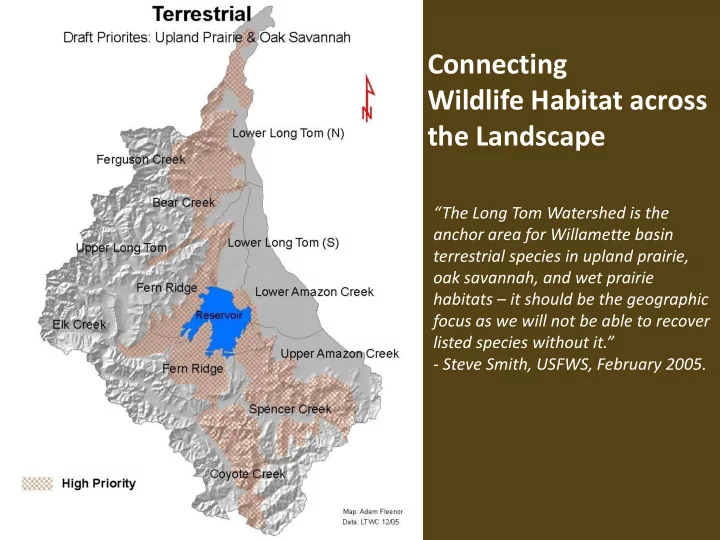

Connecting Wildlife Habitat across the Landscape “The Long Tom Watershed is the anchor area for Willamette basin terrestrial species in upland prairie, oak savannah, and wet prairie habitats – it should be the geographic focus as we will not be able to recover listed species without it.” - Steve Smith, USFWS, February 2005.
Connecting Upland Habitat across Rural Properties • Ecological Focus: wet prairie/upland prairie/savanna/woodland gradient – species composition, habitat values, connectivity • Social Focus: landowner engagement gradient – high-quality, intact and restored habitat to features: individual oaks, prairie patches, and pastures
Bird Diversity across Habitat Gradients
Habitat Value • >95 native vertebrate species associated w/ Willamette Valley grasslands, although most do not depend on them exclusively (Veseley and Rosenberg 2010) • >714 native plant species of which more than 391 are found principally or exclusively in grassland habitats (Ed Alverson, TNC, unpublished data). • >1100 species of arthropods in upland prairies (Wilson et al. 1998), including 350-400 species of native bees in oak savannas, many specialized to one plant species or genus. Today 80% are likely extirpated or extremely rare (Andy Moldenke, OSU, unpublished data). • Six federally-listed plant and insect species (USFWS 2010). • High cultural value and significance – recreational, aesthetic, spiritual Slide text by Bart Johnson
Why Manage/Restore/Preserve? • Biodiversity – wildlife, insects, plants – Pollinator services – Food, fiber, fuel • Fire adapted – Wildfire protection, land value • Economic opportunity – Grazing, NTFPs • Cultural heritage – Aesthetics, family and community histories
Photo Credit: Ed Alverson
High Geographic Priorities B est of What’s Left in Condition and Extent: • Spencer Creek • Fern Ridge south • Parts of Coyote Creek • Lower end of Upper Long Tom • Areas east of Fern Ridge Reservoir up to City of Eugene UGB Necessary to Link with Populations to the North (species dispersal and genetic diversity) • Bear Creek • Ferguson Creek • Lower Long Tom
Upland Restoration Project Locations
Slide by Bruce Newhouse
Slide by Bruce Newhouse
System Acres Percentage Conifer 28% Woodland/Forest 955,853 Historic Acreage Oak Woodland/Forest 468,090 14% Savanna 607,563 18% Overview Upland Prairie 721,997 21% Wet Prairie 330,285 10% 63% Subtotal 2,127,934 Riparian 217,823 6% Slide by Ed Alverson Marsh/Swamp 41,635 1% Water 51,205 2% Brush 1,458 <1% 9% Subtotal 312,121 Totals for WV Ecoregion 3,395,908
Connectivity What characteristics/qualities are essential for oak/prairie habitat to provide value and connections across the landscape? • Size/Acres • Gradient • Grass and forb diversity • Insects • Other?
Photo Credit: Ed Alverson
At what scales can we engage landowners? • Voluntary • Incentive based • Combination • What other scales? • How do we broaden our approach to work as a community support wildlife habitat?
Engaging Landowners • Building and diversifying uplands restoration program – Outreach • Council meetings • Wildlife habitat management calendar – Projects – Stewardship – Connectivity
Upcoming LTWC Meeting (11/27/12) • Anchor Oaks in the Long Tom Watershed: Human Connections and Habitat Values – Social and Cultural Connections – Habitat Values – Management and Restoration Opportunities
Additional Topics to Engage Landowners • Oak regeneration • Rotational grazing • Invasive plant management • Oak and prairie associated species phenology and stewardship • Landscape scale restoration of fire adapted ecosystems (Bart Johnson) • Oak habitat and bird conservation • Oak habitat and vineyards – incorporating oak habitat into vineyard planning and management
Photo Credit: Ed Alverson
Endangered and Endemic Vascular Plants of the Willamette Valley Global Federal WV Scientific Name Family Common Name Rank Status Endemic? Lomatium bradshawii Apiaceae Bradshaw's lomatium 2 LE Y Erigeron decumbens Asteraceae Willamette Valley daisy 1 LE Y Eucephalus vialis Asteraceae Wayside aster 3 SOC Y Pyrrocoma racemosa var. racemosa Asteraceae Racemose goldenweed 1 Y Sericocarpus rigidus Asteraceae White-topped aster 3 SOC N Symphyotrichum hallii Asteraceae Hall's aster 4 Y Cardamine penduliflora Brassicaceae Willamette bittercress 4 Y Lathyrus holochlorus Fabaceae Thin-leaved peavine 2 SOC Y Lupinus oreganus Fabaceae Kincaid's lupine 2 LT Y Iris tenax var. gormanii Iridaceae Gorman's iris 1 Y Sisyrinchium hitchcockii Iridaceae Hitchcock's blue-eyed grass 2 SOC Y Sidalcea campestris Malvaceae Meadow checkermallow 4 Y Sidalcea cusickii Malvaceae Cusick's checkermallow 4 Y Sidalcea nelsoniana Malvaceae Nelson's checkermallow 2 LT Y Castilleja levisecta Orobanchaceae Golden paintbrush 1 LT N Penstemon hesperius Plantaginaceae Willamette beardtongue 1 Y Navarretia willamettensis Polemoniaceae Willamette navarretia 1 Y Delphinium leucophaeum Ranunculaceae White rock larkspur 2 SOC Y Delphinium oreganum Ranunculaceae Willamette Valley larkspur 4 SOC Y Delphinium pavonaceum Ranunculaceae Peacock larkspur 1 SOC Y Horkelia congesta ssp. congesta Rosaceae Shaggy horkelia 2 SOC Y Source: Oregon Biodiversity Information Center
“We passed in going thither, several fine prairies, both high and low....The prairies are at least one-third greater in extent than the forest: they were again seen carpeted with the most luxuriant growth of flowers, of the richest tints of red, yellow and blue, extending in places a distance of fifteen to twenty miles (Charles Wilkes quoted in Boag 1992, 25).”
Recommend
More recommend